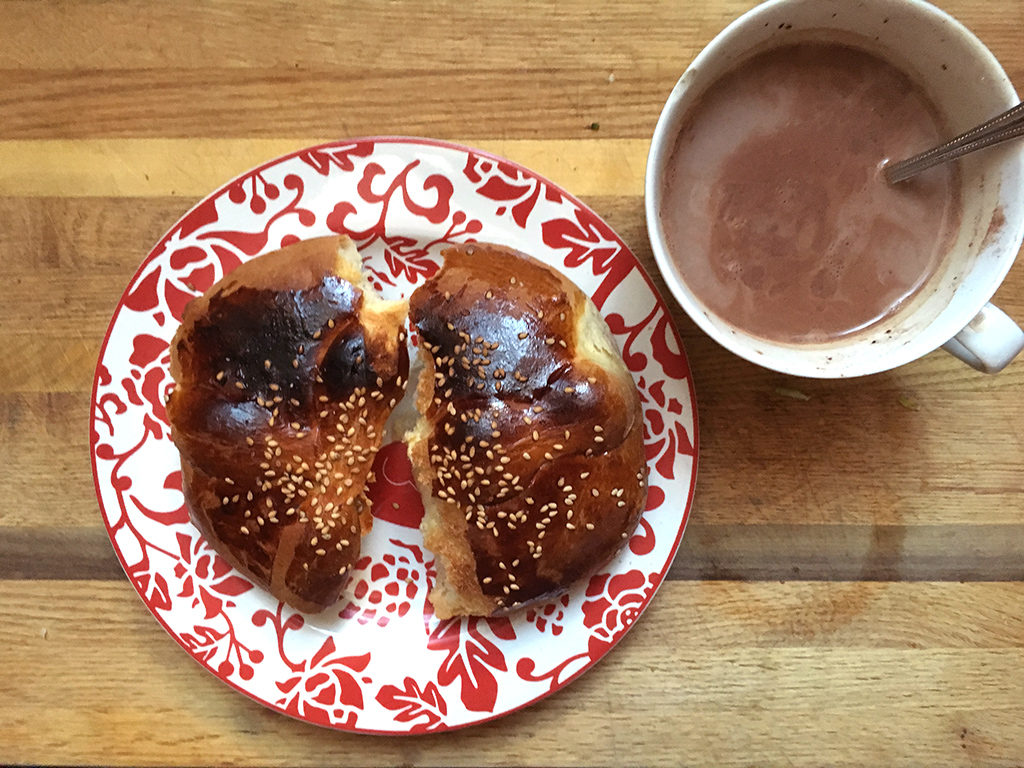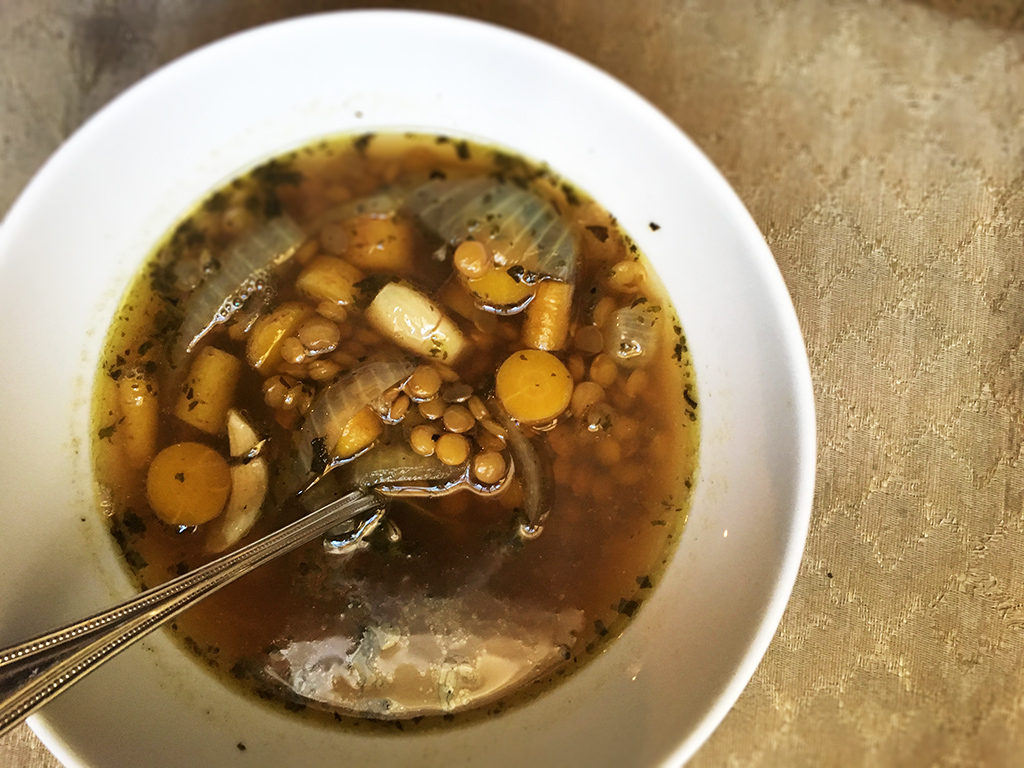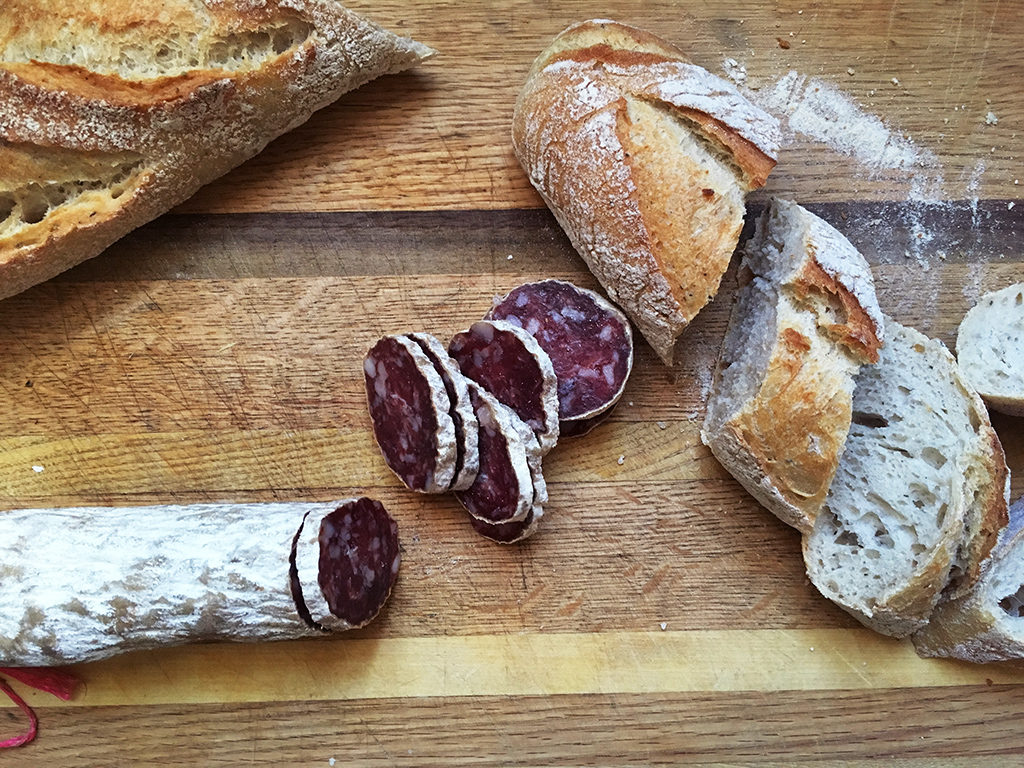Here’s what Sophhisba had to say about an Italian family’s breakfast:
Breakfast
Coffee or chocolate.
Bread, toast, or Italian cookies.For children bread and milk or oatmeal and milk. The coffee is made strong but is served with hot milk–the cup half or two thirds filled with milk before coffee is poured in. Very often nothing is eaten with the coffee.
I’m not a coffee drinker, so I opted for chocolate this morning. Although who knows, maybe this week will change me and I’ll take up the vice of coffee. I used to think my aversion to bitter flavors, like coffee, was just a me not trying hard enough to like it–but after I listened to a recent episode of the podcast Gastropod, I realized I might have a genetic aversion to bitter tastes.
I had the chocolate in my house anyways. The hot cocoa for breakfast thing is something the Americans would have pushed; in the 19th century, hot chocolate was seen as a nutritious healthy drink, especially for children. I think it’s a remnant of an older idea from when chocolate was expensive and rare; it was thought something that expensive and rare must have healthful, medicinal properties. Additionally, nutritionists were also really pushing milk in the early 19th century.
Here’s an ad from the 1880s advertising cocoa specifically for breakfast:
And a 1924 school lunch menu that also pushes cocoa:

I had my cocoa with a toasted roll, which, yes, is actually a Pan de Muerte–a sweet bread eaten for the Day of the Dead in Mexico (and Mexican neighborhoods in America). I had it in the apartment, I hadn’t gone shopping for this project yet, and it was a little old and dried out. So toasted ,it worked as an fine substitute for an Italian roll. Waste not want not. Breakfast wasn’t really great tho–all those carbs, I felt both full and hungry, which was a barfy feeling–and starving an hour later.
After breakfast, I went to vote. My polling place is on Hester Street, which runs east-west through Manhattan, through neighborhoods that were formerly Jewish and Italian, a century ago. Today, I heard English, Spanish and Mandarin spoken in my polling place. I wept with joy when I cast my vote for the first woman president.
Luncheon
Stew of spinach, lentils and onions.
Baked apples. Bread. Coffee.
Lunch was special because long time friend of Four Pounds Flour, Jill, was coming for a visit and bringing her new baby with her! I invited Jill because she is my go-to when it comes to Italian cuisine. An Italian/Jewish New Yorker herself, she is fluent in Italian and has been back to the motherland pretty much every year since we’ve met. I sat her down to help my decipher some of the menu items for this week, but there are some entries that still had us both baffled. I
We had an awesome meal that took me an hour to prepare start to finish, which really made me happy. Efficient and delicious. The lentil soup recipe came from Maria Gentile’s 1919 Italian Cookbook. I even made my own stock–I keep a zip bag of vegetable odd and ends in my freezer. When the gallon bag is full, I put it in a pot, cover it in water, bring it to a boil, then let it simmer for 20 minutes. Done.
After I strained the stock, I pulled out two carrots I had thrown in there, now cooked, and sliced them and added them to a large saucepan along with 1/4 of a white onion, 4 garlic cloves, salt, pepper, and dried parsley. I meant to throw some kale in there–instead of spinach, because I had it on hand–but Jill showed up, and I got distracted by the baby and I forgot. So when the veggies browned, I put the homemade stock over top, added a cup of lentils, and simmered about 20 minutes until the lentils were tender. We enjoyed it with hunks of fresh bread and a funky salami that Jill had brought from Eataly, and Italian specialty superstore in NYC.
For dessert, I had sliced up two Fuji apples and put them in ramekins with a little water, a tablespoon of brown sugar, a pat of butter, and a sprinkle of a “pie spice” blend. 30 minutes in the over at 375 degrees, and that was it.
I was much happier with lunch than breakfast! I was warm, satisfied–and these simple, quick foods were totally delicious.
Dinner
Macaroni with tomato sauce.
Meat (left over from Sunday).
Bread. Coffee or wine.
I made a big pot of this 1919 recipe for tomato sauce to last me the week. I used more onion and garlic than the recipe recommended, plus celery, bay leaves, and dried parsley. I browned the vegetables with oil, salt and fresh cracked pepper, then dumped an enormous can of San Marzano tomatoes and a couple scoops of tomato paste, too. I love that the recipe tells Americans “Catsup and concentrated tomato soup do not make satisfactory subsitutes as they are too sweet in flavor.” You got that right. Gross. The sauce turned out ok, not as flavorful as I would have liked, so I’ll search for ways to adjust it this week.
For tonight’s “macaroni,” I decided to use actual macaroni, dried and boxed. And I actually did have meat left over from Sunday, parts of a roast chicken, that I added to my meal. Dinner, again, was really quick and easy to prepare, and it tasted good and made me feel good. Way to go Italians!
I forgot to pick up a bottle of wine to drink with dinner, so I bought it on my way out to watch the election results with friends in Brooklyn.
I hoped for a historic day, and for our future as an inclusive country. I did not get that day.
As an entrepreneur, I am afraid my business will collapse, along with the economy. As a sufferer of a chronic health issue, I am afraid I will lose my healthcare, which I purchased under the affordable care act. As a woman and an abuse survivor, I am afraid I will be sexually assaulted, because a man will empowered to do so in this permissive climate. As an advocate for immigrants and religious freedom and those that are disenfranchised, I am afraid for my friends who are black, Hispanic, and Muslim. As a human, I am afraid for my friends who are LGBTQ. I am afraid we won’t be able to protect each other.
I do not know if I will be continuing this experiment this week.








